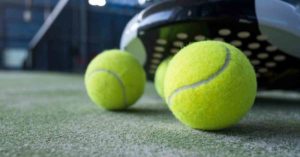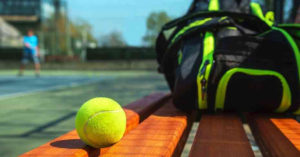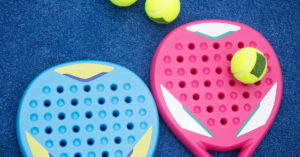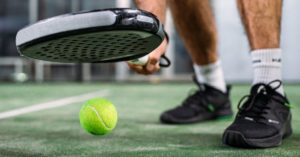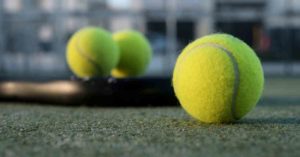- The shape of the blade
- Balance
- The frame
- The core
- Weight
And to know what suits you best you will have to look at your level, play frequency, and if you are used to handling a racket. In this post, we will cover all the points which will help you choose the right Padel racket!
Table of Contents
The shape of your Padel racket
The first thing you notice about a padel racket also called a “pala”, is its shape. If you already know a thing or two about the game, you know that it comes in three main shapes.
Even though the differences seem minimal at first sight, each shape has its advantages and disadvantages. This is because the shape of a racket will impact the balance:
- Round (balance = head light)
- Tear-shaped (balance = neutral)
- Diamond (balance = head heavy)
The further the weight is centered from the handle, the harder a racket is to handle.
Round padel racket
The round shape gives you a wider and more uniform surface area. So, even if you can’t hit the ball with the exact center of the racket, your shot can still come through.
A round-shaped padel racket is an excellent choice for beginners and defensive players who focus more on ball placement.
Round shape in a nutshell:
- Target audience: novice players
- Shape: Round
- Surface: Large
- Balance: closer to the handle
- Playing style: defensive
However, there’s a trade-off for all this convenience. Round rackets cannot generate as much power and speed as the other two shapes.
Teardrop-shaped padel
Tear-shaped rackets give you the best compromise between a round and diamond shape. The sides run sharper upwards than a round racket. This makes the surface slightly smaller and therefore a little harder to control.
So, you can pull off a wide variety of shots without losing power or control.
However, tear-shaped padel rackets will not give you as much control as a round padel or the power you get from a diamond-shaped racket.
Teardrop-shape in a nutshell:
- Target audience: players with experience
- Shape: teardrop
- Surface: Medium
- Balance: medium balance
- Playing style: versatile
Out of the 3 shapes, tear-shaped rackets offer the best compromise between power and control. This is what most players will choose
Diamond padel racket
The diamond-shaped padel has a wider top that slims down in a ‘V’ or diamond shape towards the handle. The sweet spot is much smaller compared to the other shapes. You need a lot of control and accuracy to wield the diamond-shaped padel properly
Diamond-shape in a nutshell:
- Target group: a lot of experience/professionals
- Shape: diamond
- Surface: smallest
- Balance: closer to the top.
- Playing Style: offensive
You will mostly see pros and experienced (offensive) players use this kind of racket.
What are padel rackets made of?
Coming from a racket made entirely made out of wood, the technologies and materials kept evolving to provide the best user experience possible.
The two main features to check out here are the materials that compose the impact surface and the core of the blade.
The combination of both greatly influences how padel balls react to your racket and how much effort you have to put in.
Impact Surface
The impact surface is the part of your racket that comes into physical contact with the ball when you make a shot. Rackets come in mainly three materials.
- Fiberglass rackets are usually heavier because of the composite makeup. These are often the option cheaper but also last less long
- Graphite rackets, on the other hand, are much lighter and easier to wield. These rackets have higher price tags.
- Carbon fiber has higher tensile strength compared to fiberglass. These are also slightly more expensive.
Often a mix of the 3 materials is used in different layers. The more layers, the longer the racket will last.
The composition of the racket’s blade has a direct impact on the stiffness and therefore how it reacts to incoming and outgoing balls. More layers equal more stiffness. And the stiffer the surface, the more effort you have to put in to get the needed power out of your padel racket.
The Core
The core of a racket influences how the force of the ball is absorbed and how much effort you have to use to hit the ball.
Most rackets have a core of flexible foam or stiffer EVA rubber:
- EVA (Ethylene-vinyl Acetate), or a hard core, is a material that’s known for absorbing impacts and vibrations. An EVA core is lighter, and it’s easier to regain your handling after each shot. The drawback is that they are more expensive.
- Foam (Polyethylene) or a flexible core is popular because of its comfort and flexibility. The softness also gives you an extra millisecond of control during impacts. But you get less power compared to an EVA core as most of the impact’s force is absorbed.
So take a good look at what a racket is made of and what the combination is of the core and the impact surface.
To make this a bit easier, manufacturers have written this on the frame. You can find this under “ball output” or often in Spanish “Salida de bola”. The higher the number, the smoother your racket, with 100 being the highest.
Your racket’s weight and thickness
The International Padel Federation (FIP) decides what racket thickness and weight players can use.
The maximum weights of a padel racket are determined by FIP. The standard dictates a minimum of 320 up to a maximum of 400 grams with a margin of 10 grams. It will hardly happen that rackets are made outside these guidelines, otherwise, you would not be able to use the racket (for example in competitions).
You should choose the thickness and weight based on your strength and expertise. As a general rule, we recommend the following combinations:
- Kids and juniors can use padel rackets that are about 35mm thick and weigh 320 grams or less.
- Beginners and casual players usually find it easier to wield about 370 grams. At this weight, your pala can be around 36mm.
- Women may choose rackets between 340-370 grams, depending on what they find comfortable.
- Experienced players can go for 375-380 grams with a maximum thickness of 36mm.
Remember that these recommendations are not strict rules. You can choose and transition between size, weight, and thickness based on your progress and interest.
The most important thing is not to choose a racket that is too heavy
Not too heavy
Even if 30 grams doesn’t seem like much (about the weight of 7 sugar cubes) it can make a big difference. You have to move this weight throughout a match.
Most matches last a few hours in which you may move your racket through the air a hundred times and catch balls. A difference of 30 grams is then quickly a lot, so do not choose a racket that is too heavy.
How much does a padel racket cost?
A padel racket is more complicated than your average sporting equipment. The better the quality the higher the price and price is often directly correlated to the materials that compose a padel racket.
Brands like Head, Bullpadel, Wilson are really popular among many players. Professionals like Alejandro Romo use Adidas, while Juan Chincoa uses a Babolat.
But don’t let other players’ choices sway your decision. Your choice should come down to your playing level, comfort, budget, and context.
Second-hand Padel Rackets
Buying a used pala can save you some money. So, if the budget is tight, you could consider this as an alternative. Just mind that the best padel rackets aren’t usually in the second-hand racket category.
Used rackets come with a lot of risks such as structural integrity and wear and tear. Therefore, we advise you to avoid it unless you personally know the person selling it and how long he/she has owned it.
Testing your Padel Racket
The easiest way to know which racket you should buy is to test. It is especially important to test all game situations to find out if the racket is right for you.
- Padel clubs often have several rackets that you can rent for a low rate. Or maybe a player has the model you have in mind.
- Many stores also have the option to test their products.
This way you know what suits you best before making a final and possibly expensive purchase.
Clubs and shops will have different policies, so make sure you adhere to their rules.
If this is not an option, you can always read the reviews on a trusted Padel website.
Conclusion
Shape
- round for beginners
- drop for experienced players
- diamond for pros or very experienced players.
Weight
- beginner players: between 365 and 375 grams
- experienced players: between 365 and 375 grams
- professional players: between 385 and 395 grams
Composition
- flexible core (foam) for beginners
- harder core (EVA-Rubber or polyethylene) for experienced players
Thickness
- between 36 and 38 mm
Price
- This depends very much on how often you are going to play. Cheaper rackets often last less long.
Testing
- test the racket well in every game situation before you buy it and read the reviews online.
Unfortunately, the perfect padel racket does not exist. The more you play, the more you grow within the sport. Not only do you get better at using your racket, but also how you play. Choose a padel racket that you feel best with and take enough time to decide. It is better to invest a little more in a racket that you enjoy playing with and that will last for many years than in a racket that is already worn out within a few months.



